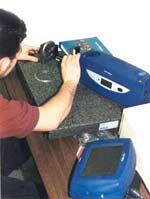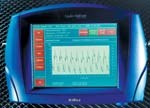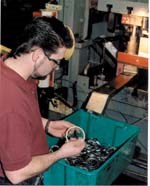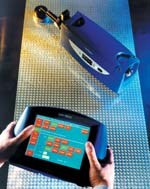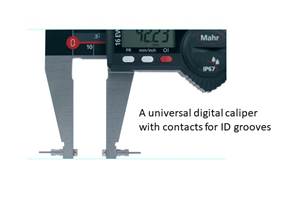Winning Seal Maker's Approval With Surface Measurement
One shop is using this important tool to bring its processes under tight control.
Share





Surface finish (a.k.a. roughness) is usually specified on part prints right along with such things as dimensional tolerances. But for many shops, surface finish evaluations have consisted of somebody eyeballing the parts and pronouncing them good enough. The uncanny ability of experienced hands to accurately "read" surface finish was the stuff of shop legends in the past. However, today's customers demand greater part accuracy and consistency, and subjective evaluations of surface finish just aren't good enough anymore. As manufacturing firms become more aware of the importance of surface finish to part performance, they are requiring their vendors to meet specified surface finishes. The vendors, in turn, are looking to gage manufacturers for surface measuring tools that are fast, accurate and easy to use.
Tryson Metal Stampings & Manufacturing, Inc., Addison, Illinois, is a case in point. The firm is primarily a Tier 2 producer of stamped wheel and engine seal components, serving seal manufacturers that supply the major automobile companies as well as heavy-equipment manufacturers.
Tryson, a QS 9000-registered company, uses statistical process control (SPC) to control its stamping operations. The firm's extensive inspection lab boasts coordinate measuring machines, optical comparators, a laser micrometer and various digital gages. But until recently, it had no surface measuring equipment at all.
"Until a few years ago, the only surface finish specification we were held to was the finish of the raw materials we purchased," explains Douglas M. Adams, Tryson's general manager. "Our customers typically further processed the seal components, imparting the desired surface finish themselves."
Then the situation changed. "In an effort to reduce costs, our customers re-evaluated the burnishing and related operations they were performing to achieve the desired surface finish on seal components," Mr. Adams continues. "They asked us to explore methods that would produce parts with the necessary surface finish right out of the die."
But before Tryson could start experimenting with ways to control surface finish, the company had to find equipment that could accurately measure it. The firm requested quotes from leading manufacturers of surface measurement equipment and attended a number of demonstrations of competitive equipment. After evaluating the options, Tryson selected the Form Talysurf INTRA surface measurement system made by Taylor Hobson Inc. Metrology Systems (Rolling Meadows, Illinois).
INTRA is a compact, portable system consisting of a traverse (measuring) unit and a separate processor control module. The two units can be connected by conventional cable or can function in a wireless mode, communicating with each other via an infrared link.
The traverse unit can be used to measure waviness, form, straightness, radius and slope in addition to surface roughness. The processor control module (photo on page 83) incorporates dedicated control and analysis software. The unit presents the user with a number of menus that permit rapid measurement, calibration, setup and control of the instrument, followed by analysis of the measurement. Analysis results are displayed on the unit's screen (photo on page 84). Measurement data can be stored for archive or later re-analysis on either the control module's internal memory or a removable, industry standard PCMCIA card.
Although the INTRA is designed for use on the shop floor, Tryson feels that the vibration generated by its 45 stamping presses would compromise measurement accuracy. Instead, the unit is shuttled between inspection areas in the firm's back-to-back production facilities. At any given time, the firm may be running three different jobs that require surface evaluation.
Tryson's first use of the surface gage involved an automotive oil seal that its customer was purchasing from a supplier in Japan. The customer wanted a domestic source for the seal and contracted with Tryson to make it—with some differences.
Hold The Compound
The OD of an oil seal is typically coated with a compound intended to prevent leaks when the seal is pressed into the bore. However, the customer wanted Tryson to make a seal that didn't need the compound, to save the cost of the material and the cost of applying it to the seal.
"The surface finish of the stamping was critical if we were going to achieve an effective seal without the compound," Mr. Adams explains. "In this application, the seal not only holds in the grease but also prevents salt, water, grit and other contaminants from getting in. Small blemishes, lines, pits or a porous surface all lend themselves to the development of leak paths. The straightness and surface finish of the stamping were critical to achieve an effective metal-to-metal seal.
"When we started producing the seal, we used a steel ball burnishing operation to close up the pores, round off the peaks, and otherwise smooth the surface of the stamped seals," Mr. Adams adds. "However, we started refining the seal stamping operation, using the INTRA to measure the impact of the refinements on surface conditions. As a result, we were able to produce stampings with just the right surface finish, enabling us to do away with the burnishing operation altogether."
The change not only reduced the cost of the stamping to the customer by 10 percent, but it also improved the productivity of the customer's seal-molding operation. The icing on the cake is that where it took the customer months to get the seals from Japan, Tryson was able to provide a 2-week delivery.
Perhaps the most important advantage of the INTRA for Tryson is that its customers accept the validity of the firm's measurement data. That's important, because as a Tier 2 supplier to the auto industry Tryson is required to submit initial samples of the part, results of a complete dimensional inspection of the samples, and information about the controls in place to assure consistent production of good parts.
Before Tryson can begin production of the part, the customer must confirm that the data provided is acceptable or turn it over to an independent testing laboratory for evaluation. "Involvement of a third party delays the acceptance process," Mr. Adams explains. "It adds 2 to 4 weeks to the approval process. If the customer cannot approve the product, he cannot receive the product. That delays issuance of the purchase order, our getting into production on the part, their receiving of the part . . . everything is put on hold."
Accuracy Confirmed
"And that's exactly what happened," he adds. "Our customer was turning over our parts and data, which included the surface measurement data generated by our INTRA unit, to an accredited lab for evaluation. The lab confirmed the accuracy of the data we supplied. As a result, the customer now accepts our initial submissions without challenge. So instead of having to wait 2 to 4 weeks for a third party lab to OK our parts, they are going right onto the customer's production lines and we can move on to the next job."
As Tryson's experience with the INTRA surface measuring unit has grown, the firm has discovered new ways to use it. The seal shown in the photos is similar to many seals made by Tryson in that it has a short cylindrical section drawn from the ID of the ring.
The drawing operation leaves draw marks, which are light lines in the drawn surface. You can see the draw marks when you hold the part up to the light, but they are so slight that you cannot feel them by running your finger over the metal. As production continues, the tooling begins to wear. The draw marks become more pronounced and eventually can develop into score lines that mar the drawn surface and cause the part to be rejected.
In the past, it was up to the press operator or quality inspector to keep an eye on the draw marks. That person usually relied on years of experience to decide when it was time to make the changes needed to prevent scoring of the piece parts. Today, however, Tryson is using its surface measuring unit to measure the growth of the draw marks as production proceeds. With it, the firm is able to quantify changes in the draw marks and make changes as needed to prevent them from turning into score marks. Tryson is currently working with some of its customers to establish criteria for distinguishing between a draw mark and a score line. And it has the tool it needs to quantitatively tell one from the other.
Need It?
Why should you be concerned about surface measurement? One reason is that dimensional tolerances are tightening up dramatically. Not too long ago, being able to hold ±0.001 inch was a big deal. Today, customers are requiring tenths tolerances from their suppliers. A tolerance of ±0.0002 inch on a turned diameter does not allow much room for variation.
A surface that appears smooth to the naked eye, when viewed under a microscope, is actually made up of numerous peaks and valleys. The profile of the surface being analyzed can be measured in many ways—from the mean line to the peaks, from the mean line to the valleys, from the highest peak to the lowest valley, and so forth. The point is that each measurement can be more pertinent than the others depending on the application of the part being measured. By and large, such measurements are beyond the capabilities of the measuring instruments on which industry has traditionally relied. They are the province of surface measurement devices that provide a whole new level of part geometric control.
The growing dependence on surface measurement is also fueled by cost-saving considerations. For example, machine shops and manufacturing plants are working hard to reduce the cost of close-tolerance turned parts by eliminating grinding and machining them completely on the lathe. Accuracy of the part is also improved by eliminating the need to chuck the part a second time in the grinder.
The key to eliminating the grinding operation is to improve the turning process enough to achieve the required surface finish in the as-turned part. But you must be able to measure the turning process before you can manage it—as was the case with Tryson's stamping operation. Again, that's where surface measurement makes the difference.
Uses for surface finish measurement continue to grow. Firms are monitoring surface finish as an indicator of tool condition, since surface finish is the first thing to deteriorate when the tool starts to wear.
Companies that are knowledgeable about surface measurement are taking the technology to the next level. In automotive, engines are getting smaller while compressions are getting higher. The car companies are exploiting surface measurement technology to help ensure that properly designed and manufactured seals keep engines running for longer periods without major repairs.
Truck engines that routinely had to be rebuilt every 100,000 miles are going several times that distance without major repairs thanks to closer fits and improved seals. Thanks to improved surface measurement equipment such as Taylor Hobson's INTRA, manufacturing firms are dramatically improving their production processes. The tools and technology are available. You owe it to yourself to see how you can use them to improve your metalworking operation.
Related Content
The Link Between CNC Process Control and Powertrain Warranties
Ever since inventing the touch-trigger probe in 1972, Sir David McMurtry and his company Renishaw have been focused on achieving process control over its own manufacturing operations. That journey has had sweeping consequences for manufacturing at large.
Read MoreHelp Operators Understand Sizing Adjustments
Even when CNCs are equipped with automatic post-process gaging systems, there are always a few important adjustments that must be done manually. Don’t take operators understanding these adjustments for granted.
Read MoreParts and Programs: Setup for Success
Tips for program and work setups that can simplify adjustments and troubleshooting.
Read MoreChoosing the Correct Gage Type for Groove Inspection
Grooves play a critical functional role for seal rings and retainer rings, so good gaging practices are a must.
Read MoreRead Next
Building Out a Foundation for Student Machinists
Autodesk and Haas have teamed up to produce an introductory course for students that covers the basics of CAD, CAM and CNC while providing them with a portfolio part.
Read More5 Rules of Thumb for Buying CNC Machine Tools
Use these tips to carefully plan your machine tool purchases and to avoid regretting your decision later.
Read MoreRegistration Now Open for the Precision Machining Technology Show (PMTS) 2025
The precision machining industry’s premier event returns to Cleveland, OH, April 1-3.
Read More











